India Nepal With Varanasi
India and Nepal – On The Footsteps Of Buddha

- 16 Days, 15 Nights
- Itinerary: Delhi – Patna – Rajgir – Nalanda – Bodhgaya – Varanasi – Kushinagar – Lumbini – Chitwan – Bandipur – Kathmandu – Delhi .
PROGRAM
TRIP LOCATION
PROGRAM
Upcoming Dates:
- 01.01.2024 – 16.01.2024 , 17.01.2024 – 01.02.2024 , 02.02.2024 – 17.02.2024 , 18.02.2024 – 04.03.2024 , 05.03.2024 – 20.03.2024 – 21.03.2024 – 05.04.2024 , 06.04.2024 – 21.04.2024 – 07.05.2024 , 08.05.2024 – 23.05.2024
Services included:
- Services of accompanying Indian Tour Leader throughout
- Services of English speaking Tour Leader in Nepal for the entire duration of stay in Nepal
- All ground transportation as detailed in the itinerary using modern air conditioned Vehicle
- Double / twin room with breakfast and dinner
- Meals : 15 breakfasts, 2 Lunches, 16 Dinners
- Monument entrance fee mentioned in the Tour Itinerary
- Domestic Airfare : New Delhi – Patna
- International Airfare : Kathmandu – New Delhi
- Early morning and evening Boat ride in Varanasi at River Ganges
- Tharu Cultural show in Chitwan
- Jungle activities in Chitwan
- Water Bottles during the Tour
- Currently applicable taxes
Services not included:
- Visa application process and fees
- International airfares & taxes
- Camera and Video charges at the monuments where applicable
- Any expenditure of personal nature such as drinks, tips, laundry, telephone charges etc
- Insurances (travel cancellation insurance, health insurance etc)
- Any new tax imposed by the government
- Any chosen optional activity / Program
TRIP LOCATION
ITINERARY
Assistance upon arrival and transfer to hotel. Welcome drink upon arrival. Check in at the hotel. Overnight at the hotel.
In time transfer to Airport to board flight for Patna, Bihar. Upon arrival meet, assist and transfer to Hotel. Afternoon is free for relaxation. Dinner and Overnight at the Hotel.
After breakfast in Hotel, leave for Rajgir. En-route visit Nalanda. Nalanda University was a great centre of learning around 1500 years ago from now. The University attracted the students from the world including Korea and China. Nalanda University flourished from 5 Century C.E. till 12 Century CE . The first residential university of the world as around 2,000 teachers and 10,000 students from different parts of the world lived and studied there. At present, ruins of Nalanda has been declared as a World Heritage Site. Later proceed further to Rajgir. Rajgir is of huge historical importance to both Buddhism and Jainism faith. Buddha gave many sermons in Rajgir and the then king Bimbisara of Magadha Dynasty was a disciple of Buddha. Lord Mahavir, the 24th Tirthankara of Jain faith spent around 14 years in Rajgir and Nalanda. In Rajgir, visit the Venuvana Vihar Monastery. This Monastery was built by Kind Bimbisara of the Magadha Dynasty for Buddha to reside. Dinner and Overnight at the Hotel.
After breakfast, drive for around 2.5 hours to reach Bodh Gaya. Bodh Gaya : We continue to follow the footsteps of Budhdha and reach Bodh Gaya, the place where Budhdha attained enlightenment under Bodhi Tree. At the age of 35 Buddha was enlightened after 6 years of practicing meditation and then later he continued to preach for another 45 years. Visit the Bodhi Tree under which Buddha attain the enlightenment and the Mahabodhi Temple, World Heritage Site. Sujata Temple, Sujata Stupa, Giant Buddha Statue (around 20 metres high) belongs to few more historical sites to visit. Dinner and Overnight at the Hotel.
After breakfast in Hotel, check out and drive further to the holy city Varanasi . Upon reaching Varanasi, transfer to Hotel and check in. Rest of the day is for relaxation. Dinner and Overnight at the Hotel.
Day will begun with an early morning Boat ride on River Ganges. The western banks of Ganges has a string of Ghats – the chain of stone steps, all built with pavilions, palaces and terraces, most of which are mailnly used as Dharamshalas where the pilgrims stay during their visit to the holy City. At dawn, the Ghats are abuzz with activity of the devotees performing their ablutions in the River or offering prayers to the rising Sun and performing other religious rituals. A Boat ride along the Ghats gives you vantage views of this activity. The Sunrise on the Ganges is a soul-lifting experience. After boat ride come back to the Hotel for breakfast and some rest. Later proceed to visit Sarnath. Sarnath - 10 kms away from Varanasi in the fabled place, which bears testimony to its great past where Lord Buddha delivered his first sermon, to his disciples, expounding the principles of Buddhism. The remains date back to as far as the 3rd century BC when Emperor Ashoka founded various institutions, stupas, monasteries and pillar Edicts. Visit the art collection at the Archaeological Museum (Museum closed on Friday). The main attraction is the superb Capital from Ashokan Pillar – the Ashokan symbol of four back to back Lions which has been adopted as the state symbol of Independent India. Also visit the Mahabodhi Buddha Temple and walk around the Deer Park. Later see the Monastery ruins area, Dhameka Stupa. In the afternoon you will visit Bharat Mata Temple and Shri Vishwanath Temple in Banaras Hindu University. It is a public central University in Varanasi established in 1916 by Madan Mohan Malviya. With over 12,000 students residing in Campus, it claims the title of largest residential university in Asia. In the evening the Ghats and temples are lit with oil-lamp lights or candles. Participate in an Arti Ceremony (collective prayer) and watch the floating Diyas (oil-lamps) on the river Ganges. Dinner and Overnight at the Hotel.
After breakfast, leave Varanasi and drive further to Kushinagar. Kushinagar is the place where Buddha died. After arrival and some rest, visit the following in the town : Parinirvana Stupa : At Parinirvana Stupa, Buddha breathed his last. The present temple is built by the Indian Government in 1956 . Nirvana Temple near to the Stupa houses around 18 feet tall reclining Buddha. Ramabhar Stupa : Lord Buddha was cremated here. Ramabhar Stupa was built to mark the place of his cremation. The Stupa is around 50 feet high. Dinner and Overnight at the Hotel.
After breakfast at Hotel in Kushinagar, check out and drive further to India-Nepal Sunauli Border. Today we’ll exit India and enter Nepal through Sunauli Border. At the border you’ll be received by our Nepal counterpart. After immigration formalities drive further to Lumbini. LUMBINI is the traditional birthplace of Gautama Buddha. According to Buddhist tradition, Maya Devi gave birth to the Buddha on her way to her parent's home in Devadaha in the month of May in the year 642 BC. Feeling the onset of labor pains, she grabbed hold of the branches of a shade tree and gave birth to Siddharta Gautama, the future Buddha. Buddhist tradition has it that he walked immediately after his birth and took seven steps, under each of which a lotus flower bloomed. In 249 BC, the Buddhist convert Emperor Ashoka visited Lumbini. Upon arrival at the Hotel, check in and relax. Dinner and Overnight at the Hotel.
After breakfast, visit Maya Devi Garden in Lumbini. Later drive to Chitwan. Lunch in the Hotel in Chitwan. CHITWAN The name 'Chitwan' has several possible meanings, but the most literal translation of the two NEPALI words that make it up: chit or chita (heart) and wan or ban (jungle). Chitwan is thus 'the heart of the jungle'. At the beginning of the nineteenth century, cultivation in the valley was deliberately prohibited by the government of Nepal in order to maintain a barrier of disease-ridden forests as a defense against the invasion of diseases from the south. Then for the century between 1846 and 1950, when the Rana prime ministers were de facto rulers of Nepal, Chitwan was declared a private hunting reserve, maintained exclusively for the privileged classes. Penalties for poaching were severe - capital punishment for killing rhino - and the wildlife in the area thus received a measure of protection. The Park consists of a diversity of ecosystems-including the Churia hills, Ox-bow lakes, and the flood plains of the Rapti, Reu and Narayani Rivers. The Churia hills rise slowly towards the East from 150 m. to more than 800 m. The western portion of the Park is comprised of the lower but more rugged, Someshwor hill. The Park shares its eastern boundary with the Parsa Wildlife Reserve. The Chitwan valley consists of tropical and subtropical forests. Sal forests cover 70 percent of the park. Sal leaves are used locally for plates in festivals and religious offerings. Later in the afternoon have a village tour. Dinner at the hotel. Tharu Cultural Show about 1 hour. Overnight at the hotel.
Breakfast at the hotel. Canoe ride about 30 mins and jungle walk to Elephant bathing Lunch at the hotel. Elephant Back Safari about 1.30 hrs into the Jungle. Dinner and overnight at the hotel.
After breakfast, drive to Bandipur about 3.30 hours. BANDIPUR, a hilltop settlement in Tanahu District. Because of its preserved, old time cultural atmosphere, it is very famous for authentic life style and preserved old homes. Bandipur is located at 27.56 N, 84.25 E and an elevation of 1100m on a mountain saddle (Mahabharat range) approximately 700m above the Marsyangdi River Valley. If weather permits, one can have the gigantic views of mountains Mt. Annapurna, Mt. Dhaulaghiri, Mt. Langtang ranges and so on. Check in at the hotel. Rest of the day for relaxation or visit the local Bandipur town. Dinner and Overnight at the Hotel.
After breakfast in Hotel, leave Bandipur and drive further to Kathmandu. On reaching Kathmandu, check in at Hotel. Rest of the day is for relaxation. Dinner and Overnight at Hotel.
Breakfast at the hotel. Sightseeing tour of Patan Durbar Square, Kirtipur, Swoyambhunath Stupa. PATAN DURBAR SQUARE Patan is situated in the center of Patan city, also known as Lalitpur, houses the residence of the former Patan royal family. Patan Square and its surroundings are good specimen of ancient Newari architecture. The city of Patan is believed to have been built in the third century B.C. by the Kirat dynasty. It was expanded by Lichhavis in the 6th century A.D. and again by the Mallas in medieval period. The Malla kings ruled the Kathmandu Valley until the ascension of the Shah dynasty. In 1768, King Prithvi Narayan Shah began his campaign to unify Nepal and Patan became a city in the kingdom of Nepal. Krishna temple of red stone, dedicated to Hindu Lord Krishna was erected in the 17th century. The temple is considered to be the first one to be constructed in Shikara architecture. Thanks to this attribute, it holds a commanding position in the durbar square. The elegant shikhara-style temple is ranked as one of the gems of Durbar Square. The temple is compared with sacred Mount Meru, which is abode of the god Shiva according to Hindu scriptures. It is also a destination for connoisseurs of fine arts, which is filled with wood and stone carvings, metal statues, ornate architecture, including dozens of Buddhist and Hindu temples. KIRTIPUR Kirtipur is one of the oldest Human settlements in the Kathmandu Valley. This tiny town is recorded as an ancient capital of Nepal. Kirtipur means “a famed town” in Nepali language is also known as “kipu” and “kyapu”. The location of this small town is different from the other main towns of the valley in the same that occupies the top of a steep rocky hill. This city of glory is inhabited and also dominated by Newars which are the earliest settlers in the Valley with their own language and cultural norms and values. Originally a Newari foundation, it is no doubt that Kirtipur is still a centre of Newari culture. It has been merged with surrounding villages to form the municipality of Kirtipur . However now a days people of differest casts and religion stay in this place. So it consists of many temples, Gumbas and Churches as well. SWOYAMBHUNATH STUPA Swayambhunath or more commonly known as Monkey Temple. The place has a lot of monkeys... This temple complex offers spectacular views of the entire Kathmandu Valley. The temple is up the hill. From the temple, you can have the whole city view from the temple. The Buddhist Stupa at the top is impressive that has eyes painted onto it. The Stupa is a golden spire crowning a conical wooded hill. It is the most ancient and enigmatic of all the holy shrines in Kathmandu Valley. It has a lofty white dome and a glittering golden spire that are visible from all sides of the valley. Historical records found on a stone inscription give evidence that the Stupa was already an important Buddhist pilgrimage destination by the 5th century A.D. i.e. before the coming of Buddhism in the valley. Dinner and Overnight at the Hotel.
Breakfast at the hotel. Sightseeing tour of Pashupatinath, Bhaktapur and Boudhanath Stupa PASHUPATINATH TEMPLE This massive temple complex sits alongside the banks of the holy Bagmati River. Only Hindus are allowed to enter the courtyard of the temple, whereas tourists can see the temple from the eastern side of the Bagmati River. It is a place where century-old Hindu rituals are practiced in their astonishing initial form, giving a chance to the visitors to feel the unique spirit of Hindu traditions of life, death and reincarnation. According to a legend recorded in local texts, especially the Nepalamahatmya and the Himavatkhanda, the Hindu Lord Shiva once fled from the other gods in Varanasi to Mrigasthali, the forest on the opposite bank of the Bagmati River from the temple. There, in the form of a gazelle, he slept with his consort Parvati. When the gods discovered him there and tried to bring him back to Varanasi, he leapt across the river to the opposite bank, where one of his horns broke into four pieces. After this, Shiva became manifest as Pashupati (Lord of Animals) in a four-face (chaturmukha) linga. BOUDHANATH STUPA There is nowhere quite like Bodhnath. Boudhnath Stupa pulses with life as thousands of pilgrims gather daily to make a kora (ritual circumnavigation) of the dome, beneath the watchful eyes of the Buddha, which gaze out from the gilded central tower. Tibetan monks in maroon robes and with shaved heads wander the prayer flag–decked streets while pilgrims spin prayer wheels and stock up on yak butter and tsampa (roasted barley flour). This is one of the few places in the world where Tibetan Buddhist culture is accessible and unfettered, and the lanes around the stupa are crammed with monasteries and workshops producing butter lamps, ceremonial horns, Tibetan drums, monks’ headgear and the other paraphernalia essential for Tibetan Buddhist life. BHAKTAPUR DURBAR SQUARE Founded in the 12th century by King Ananda Malla, Bhaktapur was the capital city of the Greater Malla Kingdom until the 15th century and was an independent kingdom from then until the 18th century. The last three Malla rulers of Bhaktapur were Jitamitra Malla, Bhupatindra Malla, and Ranjit Malla. These rulers played key roles in building the palaces and temples of Durbar Square. In 1744, Prithvi Narayan Shah, descendent of Dravya Shah, who was the founder of the Gorkha dynasty, began a conquest march in the Kathmandu Valley, capturing and unifying Kathmandu, Patan, Bhaktapur, and the smaller towns of the Valley under one rule. After a period of instability and a bloody coup in 1846, Jang Bahadur Kunwar Ranaji took control of Nepal. Dinner and Overnight at the hotel.
Today is the day for leisure in Kathmandu. Full day on leisure in Kathmandu. Dinner and Overnight at the hotel.
Breakfast at the hotel. Free time until departure transfer for the flight to India. On arrival in Delhi, free time till the departure flight back to home country. After dinner in Hotel, on time transfer to Delhi international Airport for the flight to home country.
GALLERY / PHOTOS




MORE PACKAGES
OTHER TRAVEL PACKAGES

